Collection of materials relating to neuro-ophthalmology as part of the Neuro-Ophthalmology Virtual Education Library.
NOVEL: https://novel.utah.edu/
TO
- NOVEL724
| Title | Creator | Description | Subject | ||
|---|---|---|---|---|---|
| 126 |
 |
Hirschberg Test Corneal Reflex Test | Nagham Al-Zubidi, MD | Description of the Hirschberg test a the corneal reflex test. | Hirschberg Test; Corneal Reflex |
| 127 |
 |
Testing Eye Movements | Marc Dinkin, MD | Description of eye movement testing. | Eye Movements; Exams |
| 128 |
 |
The Mental Status Examination - Non-Cognitive | James R. Bateman, MD, MPH; Victoria S. Pelak, MD | Introduction to the mental status examination. | Mental Status; Non-Cognitive Function |
| 129 |
 |
The Mental Status Examination - Cognitive | James R. Bateman, MD, MPH; Victoria S. Pelak, MD | Introduction to the cognitive mental status examination. See accompanying videos: Executive function: https://collections.lib.utah.edu/ark:/87278/s6bw1rp1, Limb-Kinetic apraxia: https://collections.lib.utah.edu/ark:/87278/s63c084b, Ideomotor apraxia: https://collections.lib.utah.edu/ark:/87278/s674... | Mental Status; Cognitive Function |
| 130 |
 |
The Clinical Examination of Higher Order Visual Function: Syndrome-based Approach - Visual Neglect | Victoria S. Pelak, MD; James R. Bateman, MD, MPH; Brianne Bettcher, PhD | Explanation of higher order visual function examination. See accompanying video, Double simultaneous visual field stimulation: https://collections.lib.utah.edu/ark:/87278/s6gn2h9d | Visual Function; Visual Neglect |
| 131 |
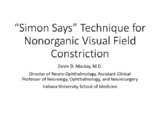 |
"Simon Says" Technique for Nonorganic Visual Field Constriction | Devin D. Mackay, MD | Explanation of the "Simon says" technique. | Simon Says, Visual Field Constriction |
| 132 |
 |
The Clinical Examination of Higher Order Visual Function: Syndrome-based Approach - Visual Simultanagnosia | Victoria S. Pelak, MD; James R. Bateman, MD, MPH; Brianne Bettcher, PhD | Explanation of higher order visual function examination. | Visual Function; Visual Simultanagnosia |
| 133 |
 |
The Clinical Examination of Higher Order Visual Function: Syndrome-based Approach - Visual Prosopagnosia | Victoria S. Pelak, MD; James R. Bateman, MD, MPH; Brianne Bettcher, PhD | Explanation of higher order visual function examination. | Visual Function; Visual Prosopagnosia |
| 134 |
 |
The Clinical Examination of Higher Order Visual Function: Syndrome-based Approach - Visual Central Achromatopsia | Victoria S. Pelak, MD; James R. Bateman, MD, MPH; Brianne Bettcher, PhD | Explanation of higher order visual function examination. | Visual Function; Visual Central Achromatopsia |
| 135 |
 |
The Clinical Examination of Higher Order Visual Function: Syndrome-based Approach - Visual Constructional Apraxia | Victoria S. Pelak, MD; James R. Bateman, MD, MPH; Brianne Bettcher, PhD | Explanation of higher order visual function examination. | Visual Function; Visual Constructional Apraxia |
| 136 |
 |
Neuropsychological Assessment | Brianne M. Bettcher, PhD; James R. Bateman, MD, MPH; Victoria S. Pelak, MD | Introduction to neuropsychology and neuropsychological assessments. | Neuropsychological Assessment |
| 137 |
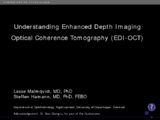 |
Understanding Enhanced Depth Imaging Optical Coherence Tomography (EDI-OCT) | Lasse Malmqvist, MD, PhD; Steffen Hamann, MD, PhD, FEBO | This is an explanation of using the enhanced depth imaging optical coherence tomography technique for examination. | Enhanced Depth Imaging |
| 138 |
 |
The Ocular Examination of the Comatose Patient | John Pula, MD | Description of conducting an ocular examination of a comatose patient. | Examination; Coma |
| 139 |
 |
The Mental Status Examination | James R. Bateman, MD, MPH; Victoria S. Pelak, MD | Introduction to the mental status examination. See accompanying videos: Executive function: https://collections.lib.utah.edu/ark:/87278/s6bw1rp1, Limb-Kinetic apraxia: https://collections.lib.utah.edu/ark:/87278/s63c084b, Ideomotor apraxia: https://collections.lib.utah.edu/ark:/87278/s67410xj | Mental Status |
| 140 |
 |
The Clinical Examination of Higher Order Visual Function: Syndrome-Based Approach | Victoria S. Pelak, MD; James R. Bateman, MD, MPH; Brianne Bettcher, PhD | Explanation of higher order visual function examination. See accompanying video, Double simultaneous visual field stimulation: https://collections.lib.utah.edu/ark:/87278/s6gn2h9d | Visual Function |
| 141 |
 |
Using Pupillometry in Clinical Medicine | Aki Kawasaki, MD | Description of the use of pupillometry in clinical medicine. | Pupillometry |
| 142 |
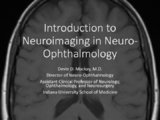 |
Introduction to Neuroimaging in Neuro-Ophthalmology | Devin D. Mackay, MD | Introduction to the subject of neuroimaging in the field of neuro-ophthalmology. | Imaging |
| 143 |
 |
Contrast Sensitivity | Sean Gratton, MD | Explanation of contrast sensitivity. | Contrast Sensitivity |
| 144 |
 |
Ocular Fundus Photography | Devin Mackay, MD | Overview of the various ocular fundus cameras and how they are used, including: Digital mydriatic tabletop fundus camera, Digital nonmydriatic table top fundus camera, Digital handheld nonmydriatic fundus camera and the Smartphone handheld fundus camera. | Digital Fundus Photography; Imaging |
| 145 |
 |
Ectropion and Entropion | Julie Falardeau, MD; Eric A. Steele, MD | This is a brief PowerPoint presentation describing 2 common disorders of eyelid position: ectropion and entropion. We provide the classification of these 2 disorders as well as clinical photographs | Ectropion; Entropion; Eyelid |
| 146 |
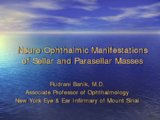 |
Neuro-Ophthalmic Manifestations of Sellar and Parasellar Masses | Rudrani Banik, MD | Neuroanatomy of the Chiasm. | Parasellar Masses |
| 147 |
 |
Distance Visual Acuity Testing | Sean Gratton, MD | Demonstration of measuring distance visual accuity. | Visual Acuity Testing |
| 148 |
 |
Lagophthalmos | Julie Falardeau, MD; John D. Ng, MD | This is a brief PowerPoint presentation for the NANOS Examination Curriculum describing how to evaluate lagophthalmos, discussing the main causes of lagophthalmos and demonstrating few clinical examples. | Lagophthalmos; Eyelid |
| 149 |
 |
Tonometry | Ore-ofe Adesina, MD | Presentation covering the measurement of intraocular pressure, Tonometry. Covers indentation, applantation and electronic tonometry. | Tonometry; Intraocular Pressure |
| 150 |
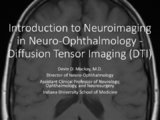 |
Diffusion Tensor Imaging (DTI) | Devin D. Mackay, MD | Explanation of using diffusion tensor imaging (DTI) in examinations. | Diffusion Tensor Imaging (DTI) |
